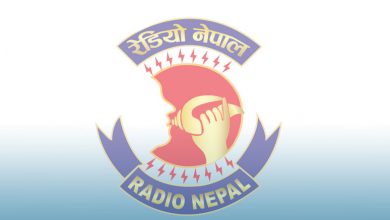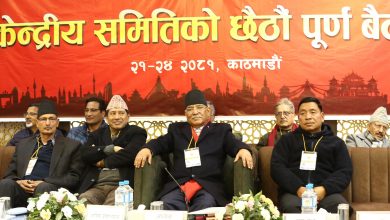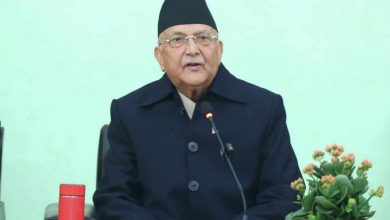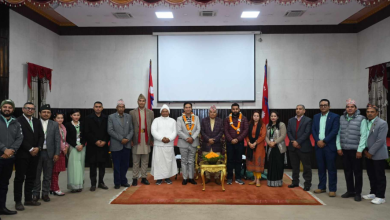Nepali film market expanding abroad thanks to digitalization
Kathmandu: The market of Nepali film is gradually expanding abroad lately. The expansion is attributed to a number of reasons with optimization of digital technology for the production and screening of the films being a top cause.
The expanding market in the countries where a large number of Nepalis reside as well as in other countries is also increasing the belief that the expansion would further boost the annual Rs 1.65 billion-worth Nepali film market.
In the initial days, films were screened using celluloid technology which limited the scope of film shows to within and outside the Kathmandu Valley only. The screening time used to be changed in the cinema halls and they used to transport the small boxes of reel from one movie hall to another to show a movie.
However, the time has changed now. The scope of the Nepali film market is expanding even at home and outside with the departure from the traditional approach in the production and screening of films and due to the optimization of digital technology, innovative promotional events overseas and increasing presence of Nepali movies in the international film festivals.
Nepali films are now shown not only in Nepal but also across the globe simultaneously provided permission for worldwide screening is granted timely.
At present, Nepali films are relying on various digital platforms such as YouTube as the Over the Top (OTT) platform has an inadequate number of Nepali movies. Nepali movies thus have to be screened in the cinema halls at first to earn the first audience.
The changing pattern of movie making and its expanding market are increasing challenges and concerns along with cheers. Retaining loyalty among the growing number of audiences has emerged as the top challenge for the filmmakers of late, admit filmmakers.
Film director Sunil Pandey shared, “Celluloid films (meaning films made using reels) were produced on the basis of manual work, experience and acumen of the makers. Even the director of the film could not see the scenes filmed until the post-production works. One had to watch the film through the gaze of cinematographer.”
Another film director Gyanendra Deuja opined that in those days audiences did not have any other platforms to watch films except for the movie halls. Hence, audiences thronged the movie halls in droves.
“There were no platforms like OTT like now. The audiences had little choice about watching the movie due to the limited number of movies made in those days and the limited number of movie halls. Thus, they used to come to the movie halls to watch the movies which were mostly made surrounding love themes or exploitation under feudalism,” he narrated.
Producer and director Ashok Sharma viewed that the attraction of Nepali movies is far more among the rural audiences than urban. Sharma has experienced the craze and affection of audiences for movies first-hand by visiting movie halls during the movie screening.
Illustrating audiences’ craze and affection, he cited the movie ‘Truck Driver’ produced by him being screened across the country some three decades ago.
He recalled, “I went to Surya Talkies (Hall) in Urlabari, Morang along with the artists in the movie. Over 1,500 people were desperately waiting in the hall and had 500 seat capacity to just take a glance at the cast of the film.”
“The audiences used to get fainted due to hot and humid weather since it was summer and perhaps due to excessive excitement!” quipped Sharma, sharing another anecdote of how the fainted audiences would enthusiastically enter the hall to watch the movie over again after regaining consciousness.
“The attention span of the audiences towards the screen was such that they would not go home until the movie was over.” The cast of the films used to ‘meet and greet’ the audiences in celebration of the film crossing 51st day of screening.
This is a narrative of those days when a handful of celluloid films were made and released annually. In the last five years, on average 60 to 70 movies have been released annually.
Nowadays, digital technology is used from film production to screening and it is also leveraged to expand its market globally. Digitalization has contributed to both qualitative and quantitative growth of the Nepali film market, agree filmmakers.
It may be noted that the Nepali film industry embarked on its digital journey with the film ‘Kagbeni’ directed by Bhusan Dahal. Film production became easier, more organized and more professional with the introduction of digital technology, according to directors and producers. There is no longer the compulsion of dashing off one hall to another with boxes of reels to show a movie.
Digital technology is ushering in new standards of filmmaking and enabling simultaneous screening of films all over the country and outside. This has cut down the long list of films waiting for their turn to be screened in Kathmandu.
The credit goes to producer Ashok Sharma and his vision to adopt and optimize digital technology to facilitate the distribution of cinema content to cinema halls across the country.
He formed a group of exhibitors, distributors and producers and established Digital Cinema Nepal (DCN) in 2007. “We started off by collaborating with an Indian technology- UFO Server- acknowledging the need for the digital technology to bring about positive changes in the perspective of urban Nepali audiences towards Nepali movies and to ensure quality screening.”
According to him, Nepal was the first country in the world to optimize digital technology through and through in filmmaking from production to screening. “Since the market size of the Nepali film is relatively small, there is not much discussion about it,” he bemoaned.
In the past, filmmakers had a hard time attracting urban audiences to the movie halls given the quality issues in screening. The reels of the films brought from mofussil often used to be broken and scratched thereby resulting in poor screening. Much to the dismay of audiences, movies could not be shown clearly and cleanly in some movie halls with single screens, he said.
Producers and directors were enthused by the advent of digital technology as it boosted the quality as well as the number of Nepali films that could be shown in 175 digital cinema halls of the country at the same time as foreign movies.
The servers of the UFO and Cube Digital are currently showing Nepali movies across the world in the Digital Cinema Initiatives (DCI) format. All technology used in movies is encoded in Nepal at present.
Even after the adoption of digital technology, producers who were freed from reels-era filmmaking had to go to India for encoding in the initial days. Separate encoding was needed for the DCN and Cube Digital before DCI. Technology has made it easier. Now, encoding in the single serve can enable worldwide screening simultaneously.
Movies such as ‘Mahapurusha’, ‘Chakka Panja 4’ and ‘Jari’ were encoded here and screened all over the world, he shared, adding that it resolved the problem of privacy once for and all and spared the producers the hassle of taking movies’ reels abroad for screening.
Lately, Nepali movies are not only drawing good returns on investments but also making good profits from the international market. The Nepali film market is growing gradually abroad as the Nepali audiences there started watching Nepali films made from recognized banners.
Nepali movies with unique or original stories and artistic presentations are tapping the market in Australia, Japan, the USA and the UK among others. Nepali movies once shown in some community halls and restaurants abroad are finding spaces on big screens too.
Prateek Subedi, Director of Nepal Eleven Entertainment LLC, a company authorized to distribute Nepali movies in the USA, observed the change in the style of screening Nepali movies abroad. Earlier, audiences had to individually book an entire hall for a certain hour for the screening of the movie.
According to him, the ticket fee for the movie shown in the booked hall would be costlier than the ticket purchased at the box office. “The fee charged for booking and screening the film is almost double the usual fee. The exhibitor ought to shoulder management-related responsibilities solely. There is no hassle regarding management if we screen the movie in the box office system,” he explained.
He shared he was further encouraged about the prospects of the Nepali film market in foreign lands after ‘Prem Geet-3’, ‘Mahapurusha’ and ‘Jari’ among other Nepali movies were shown regularly through the box office system and those movies grossed significant collections.
Director Ram Babu Gurung gushed that the distribution right for foreign screening of two of his upcoming films has been almost sold by now. He said, “The sales might have been due to the business done by our previous movies. It is understood that movies made in our banner are in demand abroad.”
According to him, the Nepali movies were also promoting Nepali arts and cultures among the Nepali diaspora besides expanding its market internationally.








Comments